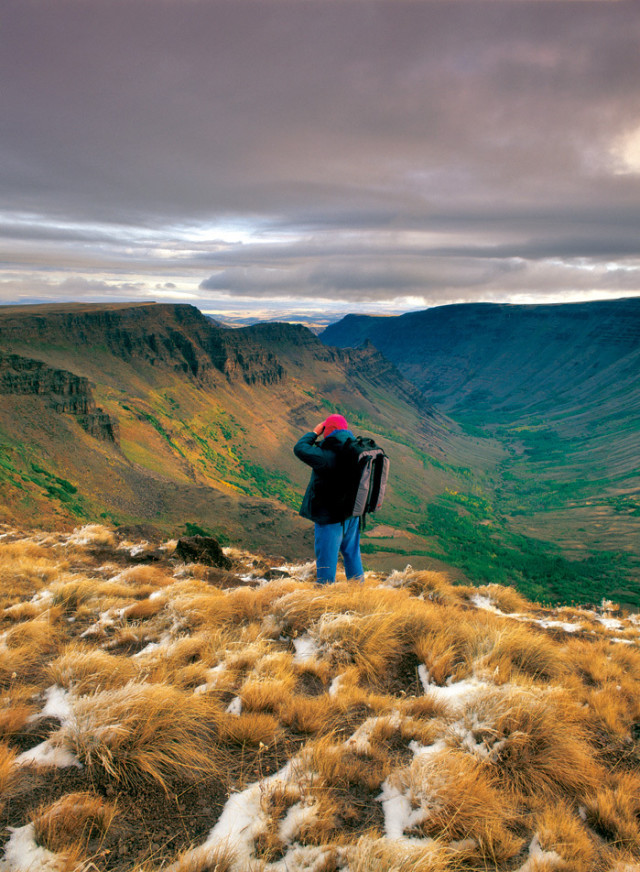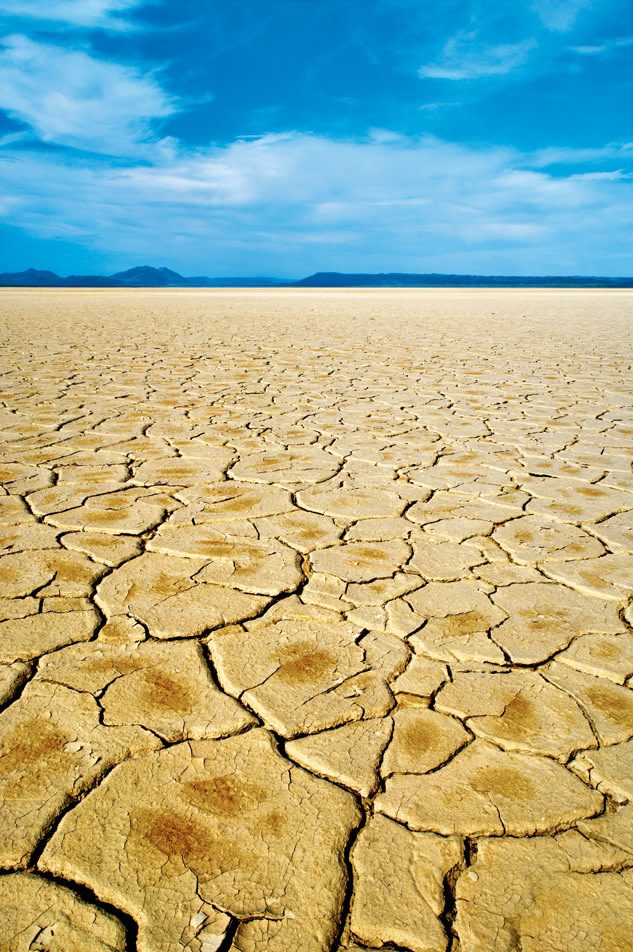High Lonesome

On the rim of Kiger Gorge, which cuts into Steens Mountain
Image: Dennis Frates,Dennis Frates
As the wings of the 1954 Cessna clear the peaks, Jake Ruhl, a private pilot from Bend, eases the engine back to a quiet murmur. Not far below, the drowsy slopes of Steens Mountain in southeastern Oregon have suddenly given way to a jigsaw expanse of gnarled ravines and ridges that crumble toward the east. There on the horizon, an otherworldly sea of brilliant white sand stretches for miles in every direction: the Alvord Desert, a perfect place to land. The altimeter dial spins languidly—9,000 feet, 8,500, 8,000—as we drift toward the flats on a warm cushion of air.
After the wheels tap the ground, Ruhl guns the engine, and we rocket across the midriff of a 66-square-mile alkali lakebed, the landing gear skipping across the cracked sand like stones over water. In minutes we’re within eyeshot of remote hot springs that burble nearly a vertical mile below the rugged peaks. Ruhl kills the engine, and we step out of the plane. Except for a small group of campers in the distance, we are alone.
There are of course more conventional ways to reach Steens Mountain and the Alvord Desert in Harney County. You could drive seven hours or so from Portland or four from Bend, but the result is always the same: a rollicking adventure in a landscape of surreal emptiness and supreme beauty unlike anything offered in the boot-packed Cascades.
Just 7,600 people live in the 10,000-square-mile county.
Steens Mountain, named after 1860s explorer Enoch Steens, is one giant slab of basalt cocked up like a 30-mile-long ramp. It reaches 9,733 feet into the sky and stretches some 50 miles along its crest, making it the largest “fault block” mountain in the Great Basin. The western slope is gentle, with aspen coppices, wild Kiger mustangs, and glacial valleys carved into giant U’s that beg for hiking and horseback riding. The eastern flank drops precipitously toward the Alvord in a jumble of eroded rock that dissolves into the desert’s dusty nothingness below. In between, volcanic forces fire a handful of hot springs and antelope bounce through thigh-high grass, while above eagles hunt on the updrafts. This also happens to be the sole home of the Borax Lake chub, a federally endangered desert minnow whose entire habitat comprises a single shallow lake.
Best of all, no one is here—locals included. Ten-thousand-square-mile Harney County, Oregon’s largest, claims just 7,600 people, a population so sparse that state officials consider this remote region “frontier.” Indeed, bovines outnumber bipeds nearly seven to one, and many of the folks who live off these gravel roads still work as ranch-hand buckaroos. It’s the kind of place where the Wild West endures in place-names like Whorehouse Meadows and Corral Creek, and in the history of at least one gunfight—a settler named Ed Oliver shot ranch owner Pete French right off his horse in 1897 after the two had argued over land and water.
Today things are much more sedate. A few anglers fish the crisp rivers and streams such as Little Blitzen. Trails weave past century-old cabins and bear few footprints. Places to camp under skies unsullied by lights abound—yet there is no need to subsist on cowboy-style rations of pork and beans. The Hotel Diamond, a time-worn inn in the Diamond Valley on the Steens’s northern tip, has excellent beef Wellington, plenty of wine and rooms creaky enough to cause hallucinations of ghosts.
{page break}

The thirsty Alvord Desert
Image: Dennis Frates,Dennis Frates
My own Steens adventure began when a friend and I scooted out of Bend early one Friday afternoon and checked into the hotel, which once housed the town’s tiny post office and today remains the only place within about 40 miles to get a beer. Ruhl and two more of our friends would arrive later with the plane. In the meantime, we sat in lounge chairs on the porch and whiled away an evening beneath a mason-jar chandelier.
The mercantile and saloon have been lost to weeds and poplars.
The town of Diamond used to have all of 50 people back in the early 1900s, when Basque herders and homesteaders ran sheep on the mountain. That was before America lost its taste for mutton and the town withered, losing its two mercantile shops and a saloon to weeds and poplars. Now livestock are banned from grazing on at least 100,000 acres in the Steens Mountain Wilderness, but the hotel, an ambling hulk of dark wood built in 1898, has carried on just as ranching has. Locals with sandpaper hands frequent the hotel on weekends for dinner, when owner Shirley Thompson and her grandchildren serve fresh bread and stiff coffee. And Diamond is on an upswing once again. The year-round population jumped 33 percent—to four people—last March when Justin McAulay was born to the family across the street.
Frenchglen, a town about 30 miles south of Diamond that serves as another jumping-off point for Steens, is huge by comparison—population 15. On a roundabout approach to the town—named after that same Pete French and his father-in-law Hugh Glenn—we drove through lion-colored hills and stopped to poke around one of the state’s last circular corrals, or “round barns,” used for breaking horses in the early 1880s. Back then French’s ranch, one of the largest in the nation, covered a whopping 200,000 acres, and the town survived by supplying its workers with food and drink and mail. The ranch started falling apart after French was shot, and by the end of World War II, the town had all but withered away.
Today there isn’t much in Frenchglen—a school, a few homes, and a mercantile with shelves so bare I wonder whether it’s open. Despite the ghost-town setting, rooms are all booked at the Frenchglen Hotel, an eight-room relic of the stagecoach days built in the 1920s. So we pitch tents in Page Springs Campground near a lazy creek on Steens Mountain’s western slope. When Ruhl arrives, our group grows to five.
We spread a map out on a picnic table and pick a hike to do in the morning, an eight-mile push into Big Indian Gorge, one of four glacier-carved valleys. We don’t even make it halfway, instead choosing to nap on warm rocks by the river. In spring and early summer, these gorges turn bright green as the meadows drink melt water. Alpine lakes twinkle in their bellies, and wildflowers—Indian paintbrushes, lupines and daisies—burn around their banks. The urge to meander through them is inescapable.
Or fly over them, as the case may be. Ruhl takes off from a remote landing strip near the mountain, and soon we’re drifting through the deep walls of Kiger Gorge. He guns the engine over the crest and puts the plane down in the desert. Today it’s too hot for a soak in the 102-degree water of Alvord Hot Springs—a concrete pool sunk in the desert—so Ruhl flies to Fields, a one-building town on the Alvord’s southern end, to fetch burgers and milkshakes.
I stay behind and walk out onto the playa. Less than seven inches of rain falls here a year, making the Alvord Oregon’s most arid region. A gentle breeze stirred by the heat rising off the sand carries away the dust from my footsteps. Each stride I take seemingly brings me no closer to the mountains lingering in the distance. There is no frontier here. Sky and sand blur into a sea of hazy ripples.




